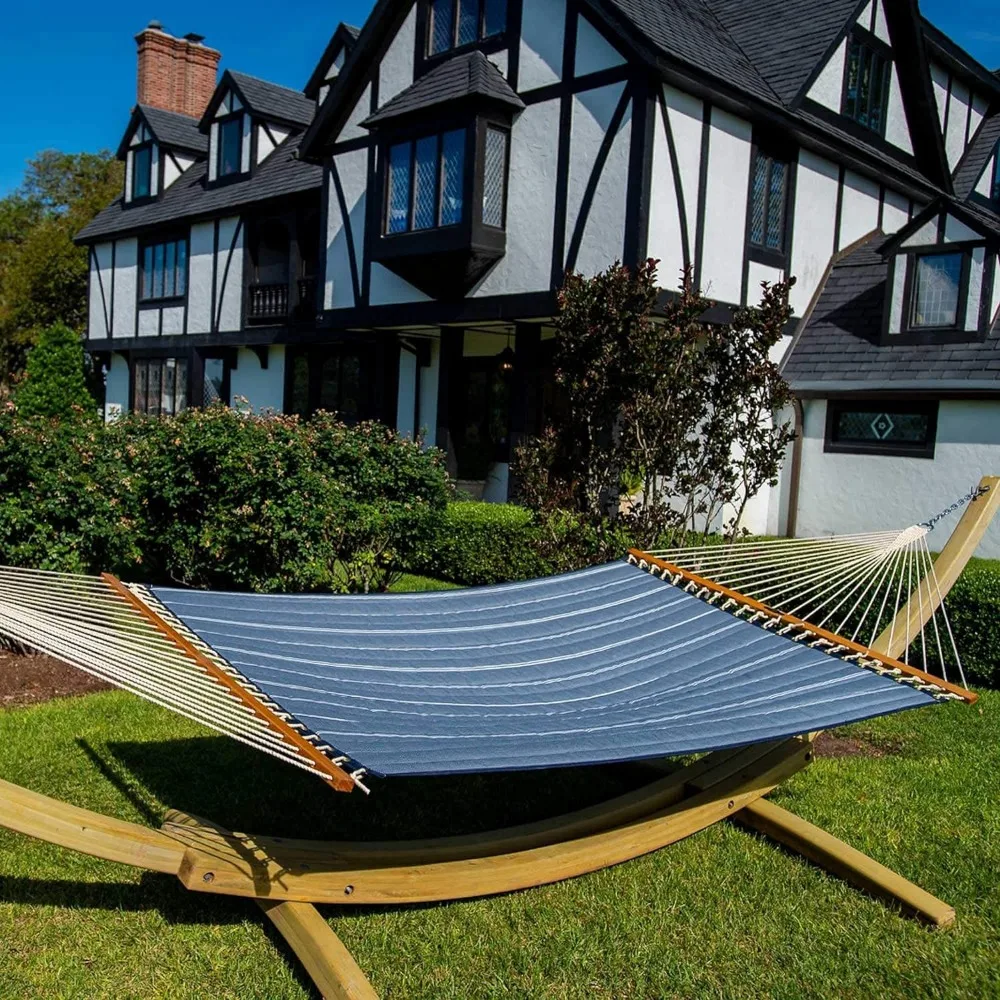Dozing off in a hammock is one of life’s simple pleasures, allowing you to relish a peaceful nap while basking in the beauty of the outdoors. However, like any outdoor gear, hammocks can accumulate dirt, sweat, and the inevitable traces of nature, detracting from your relaxing experience. An unclean hammock can harbor bacteria, mildew, and unpleasant odors, reducing its lifespan and comfort. If you want to ensure your hammock remains a pristine oasis of relaxation, learning how to wash it properly is essential. This comprehensive guide, “Keep Your Hammock Fresh: Step-by-Step Guide on How to Wash a Hammock,” provides you with all the insights and steps needed to maintain your hammock in peak condition.
Understanding Your Hammock Material
Before embarking on the cleaning process, it is crucial to understand your hammock’s material, as different materials require varied care approaches. Hammocks generally come in fabrics such as cotton, polyester, nylon, or a blend. Cotton hammocks tend to be softer and more comfortable but are more susceptible to mold and mildew due to their moisture-absorbing nature. Nylon and polyester hammocks are more durable, weather-resistant, and dry faster, making them easier to clean. Always consult the manufacturer’s label or guidelines to ensure you adhere to specific cleaning instructions for your hammock type.

Gathering Necessary Supplies
A well-prepared cleaning session begins with assembling all the necessary supplies. For a standard cleaning job, you will need water, a mild detergent (preferably one that is biodegradable and unscented), a soft-bristled brush or a sponge, a bucket, and access to a hose or a large water source. For more stubborn stains or mildew, having white vinegar or a specialized hammock cleaner on hand is advisable. Before you start, ensure there is ample sunshine and a well-ventilated area for drying your hammock after washing.
Detaching and Preparing the Hammock
Most hammocks can be easily detached from their support, which is essential for thorough cleaning. Remove all accessories such as spreader bars, carabiners, and ropes. Take note of the way your hammock is assembled, and even take photos if necessary, to make reassembly easier later. Lay the hammock flat on the ground and inspect it for any visible dirt spots, tough stains, or signs of damage. Address any minor repairs before washing to prevent further deterioration during cleaning.
Hand-Washing Your Hammock
Hand-washing is the gentlest method and often recommended by manufacturers to prolong your hammock’s life. Fill a bucket with lukewarm water and add a small amount of mild detergent. Submerge the hammock into the soapy solution and gently agitate it with your hands. Use a soft-bristled brush or sponge to remove dirt, paying extra attention to heavily soiled areas. For stains, apply a mixture of water and white vinegar directly to the spot and scrub gently. Avoid using harsh chemicals or bleach, as they can weaken the fabric fibers. After a thorough wash, rinse the hammock with clean water until all soap residue is gone.
Machine-Washing Your Hammock
If hand-washing is not feasible, and your hammock’s care label permits, a washing machine can do the job effectively. Use a front-loading machine to avoid tangling and damage that can occur in a top-loader with an agitator. Place the hammock in a large laundry bag or pillowcase to protect it. Select a gentle cycle with cold water and add mild detergent. Do not use fabric softeners, as they can leave a residue on the fabric. Once the cycle is complete, it is crucial to rinse the hammock thoroughly by running an extra rinse cycle to ensure no detergent residue remains, which can attract dirt and weaken the fabric.
Drying Your Hammock Properly
Drying your hammock correctly is paramount to maintaining its shape and fabric integrity. Never use a dryer, as the heat can damage the material. Instead, find a well-ventilated area with ample sunshine and spread the hammock out flat or hang it to air dry. Ensure that it is not in direct contact with the ground to prevent dirt and insects from sticking to it. Rotate the hammock occasionally to promote even drying. Avoid folding or storing the hammock until it is completely dry to prevent mildew and unpleasant odors. Depending on the material and weather conditions, drying can take anywhere from a few hours to a full day.
Tackling Tough Stains and Mildew
Persistently tough stains and mildew can mar the beauty of your hammock, but with the right approach, they can be effectively addressed. For mildew, mix one cup of white vinegar with one gallon of water and apply it generously to the affected area. Let it sit for about 30 minutes before scrubbing with a soft brush or sponge. Rinse thoroughly with water. In cases of severe mildew, a specialized mildew cleaner may be necessary. Stubborn stains can be treated with a paste made from baking soda and water, applied directly to the stain and scrubbed gently. Always perform a spot test in an inconspicuous area before applying any cleaning solution to ensure it does not damage the fabric.

Reassembling and Maintenance Tips
Once your hammock is clean and dry, it is time to reassemble it. Refer to the photos or notes you took during disassembly to ensure correct reattachment of any parts or accessories. Regular maintenance can extend the life of your hammock significantly. Store it in a dry, cool place when not in use, and avoid leaving it exposed to the elements for prolonged periods. A hammock cover can provide additional protection against dirt and weather. Routinely inspect your hammock for signs of wear or damage and address any issues promptly.
Seasonal Cleaning and Storage
Even with regular maintenance and occasional spot cleaning, giving your hammock a thorough seasonal cleaning is beneficial. Depending on usage, plan for a comprehensive wash at least once or twice a year. Before storing it away for the off-season, ensure it is completely clean and dry. Choose a storage bag that is breathable to prevent mildew and rot, and store it in a dry, temperature-controlled environment. Avoid storing it in direct sunlight or damp areas like basements or garages, as these conditions can degrade the fabric over time.
Environmental Considerations
When washing your hammock, it is essential to consider the environmental impact of your cleaning practices. Opt for biodegradable, environmentally-friendly detergents to reduce water pollution. Washing your hammock by hand uses less water and energy compared to machine washing. Moreover, air drying not only preserves the fabric but also saves energy. By adopting eco-conscious cleaning methods, you help preserve not only your hammock but also the natural spaces you enjoy.
Protecting Your Hammock from Common Hazards
Outdoor environments expose your hammock to a variety of hazards, including sun damage, rain, and wildlife. Prolonged exposure to UV rays can weaken the fabric fibers, causing them to fade and become brittle. Whenever possible, hang your hammock in shaded areas or use a UV-protective spray designed specifically for outdoor fabrics. During inclement weather, it’s best to store your hammock indoors to prevent water damage. Wild animals, such as birds or rodents, can also pose a threat by gnawing on the fabric or leaving droppings. Always inspect your hanging spot before setting up your hammock to minimize interactions with wildlife.

Conclusion: Keep Your Hammock Fresh: Step-by-Step Guide on How to Wash a Hammock
A hammock offers countless hours of relaxation and enjoyment, and with proper care, it can remain a treasured part of your outdoor gear collection for years. Through this “Keep Your Hammock Fresh: Step-by-Step Guide on How to Wash a Hammock,” you are now equipped with the knowledge and techniques to maintain your hammock’s cleanliness and longevity. Remember, the key to a fresh and inviting hammock lies in understanding its material, using appropriate cleaning methods, and committing to regular maintenance. So go ahead, embrace the art of hammock care, and enjoy a fresh, clean retreat every time you lounge amidst the trees.
